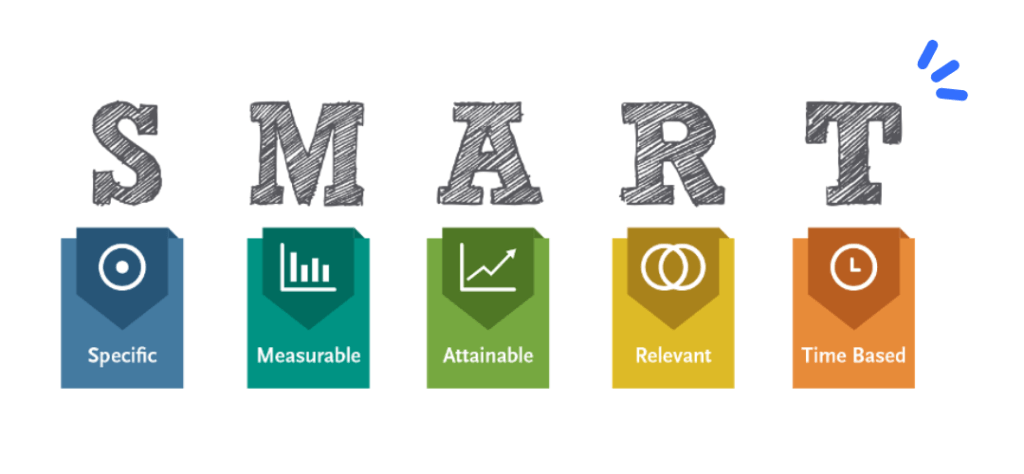What on earth is a rock? (Apart from that thing you always trip over when walking out your front door?)
Rocks, believe it or not, are what take your business to the next level. Having SMART rocks in place will help you achieve team alignment and help your business unlock the next level of growth.
Let’s look at what it means to have rocks in your business. What are the benefits you’ll see from using them, and what are the do’s and don’ts when creating them?
What exactly is a rock?

A rock is simply a business goal. Big rocks are your three or more more truly important priorities or goals to get done in the next quarter.
The theory comes from Steven Covey’s BIG rock theory which is all about prioritizing the most important tasks in your life or business.
Picture it like this: you have a jar and a bunch of different-sized rocks, pebbles, and sand. You need to fit everything into the jar, but if you start with the sand or the pebbles, you won’t have enough room for the big rocks.
The key is to start by putting the big rocks in first, making sure they fit snugly into the jar. Then you can add the pebbles and sand, filling in the gaps.
In business, this means identifying the most important tasks or projects and prioritizing them over the smaller, less important ones. By tackling the big rocks first, you ensure that you’re making progress on the things that matter most to your success.
So, don’t get bogged down by the small stuff – focus on the big rocks and watch your business thrive!
Okay but what are SMART rocks?
Did you know that you’re 33% more likely to achieve your goals if you write them down, share them, and provide regular updates on them?
Yet, according to a Harvard Business Study, only 3% of people write out their goals.
And that 3%? They’re the people who go on to earn as much as 10X the income the remaining 97% do.
So if generating more revenue is even a tiny part of your business plan, you better get to work identifying, documenting, and scaling goal-setting processes across your organization.
And there’s no better way to ace that task than by setting SMART Rocks; Specific, measurable, attainable, realistic and time bound.
Let’s dive into everything you need to know about Rocks: what they are, the benefits you’ll see from using them, and the dos and don’ts when creating them.
With the right goals and approach, you’ll be more than ready to ‘rock’ it. 😜

Okay, so you’re on board with the Rock revolution. Next, it’s time to put pen to paper and set your Rocks for the next 90 days.
It’s important to remember that the number one reason Rocks fail is that they’re not SMART. This means that they’re potentially not;
- Specific — Keep them short and to the point, with no room for confusion.
- Measurable — If you can explain what it means when something is ‘done,’ it’s measurable.
- Attainable — Ambitious but achievable.
- Realistic — Don’t overestimate/underestimate your skill, time, or resources.
- Time-bound — Ensure it has a deadline. With Rocks, it’s always 90 days.
If your Rocks don’t meet the SMART standard, they’re a lot less likely to be successful — but that isn’t the only issue that can make or break your success with Rocks.

Why rocks fail?
When a Rock fails, 99% of the time, it’s because it was not truly SMART. In other words, it couldn’t be measured, defined, or achieved in a specific time frame or it simply wasn’t attainable or relevant.
If you don’t achieve a Rock, analyze what went wrong, and then make adjustments for the future.
With just a little practice, you can achieve great Rocks every 90 days!
How to create the perfect rock?
Big rocks are powerful tools to gain traction on the corporate vision and move forward.
BUT the fewer, the better. It’s typically recommended to set between 3 and 5 rocks in order to make them achievable.
The key to setting big rocks in a scaling business is to prioritize the activities that will have the most impact on achieving your long-term vision. By aligning your team, setting measurable goals, and regularly reviewing progress, you can ensure that you’re making progress on the things that matter most to your business success.
Define your vision
Before setting any goals or priorities, you need to have a clear understanding of your business vision. What do you want to achieve in the long-term? What is your ultimate goal?
Identify your top priorities
Based on your vision, identify the top priorities that will help you achieve it. These are your big rocks. Consider what activities, initiatives or projects are most critical to your success.
Align your team
Make sure your team understands your vision and agrees with your top priorities. Involve them in the process of setting big rocks, and ensure everyone is on the same page.
Make it measurable
For each big rock, set specific and measurable goals that will help you track progress and ensure accountability. Make sure these goals align with your overall business objectives
Assign Ownership
Assign ownership of each big rock to specific individuals or teams. They should be responsible for ensuring progress is made and the goals are achieved.
Review progress regularly
Review progress against your big rocks regularly, and make adjustments as necessary. Celebrate successes, and learn from failures.
What are examples of SMART rocks
-
Define the goal: Increase customer satisfaction ratings by 10% by the end of the quarter.
-
Identify the key initiatives: To achieve this goal, the customer success team could focus on initiatives such as:
- Conducting regular customer feedback surveys and analyzing the results to identify areas for improvement.
- Providing additional training and resources to customers to help them get more value from the product.
- Increasing proactive outreach to customers to address issues before they become problems.
-
Assign ownership: Assign ownership of each initiative to specific team members. For example, one team member could be responsible for managing the feedback surveys, while another could be responsible for creating and delivering additional training resources.
-
Track progress: Set up a system for tracking progress against each initiative and the overall goal. For example, you could track customer satisfaction scores on a weekly basis and review survey results each month.
-
Review and adjust: At the end of the quarter, review progress against the goal and identify any areas for improvement. Celebrate successes and learn from failures to continually improve the customer experience.
This was an ACTUAL example from one of our rocks at Whale, and the result was that in the Spring G2 reports of 2023, Whale achieved leader status in 4 categories! As well as a bunch of badges!

Five reasons why Rocks rock 🤘🏾
Here are the top five reasons Rocks deserve a place in every growth strategy:
- Laser-focused employees: Goal-setting and tracking help employees prioritize — if in doubt, follow the Rocks.
- Greater accountability: Assigning each employee a goal to own gives them instant accountability. There’s no hiding from responsibility when your name’s on it.
- Clarity: Well-documented goals give your employees a clear north star. What’s the next step? What’s the priority? Should I do this or that? Circle them back to their Rocks for the answer and let them be their guide.
- Problem-solving: Let’s face it; it’s easier to run away from a problem than to face it head-on. But with the right Rocks in place, running isn’t an option. Instead, you’ve got to identify the issues and work through them.
- Results: With a more focused and accountable team, one that is supported by a documented process, your productivity is set to soar (and so is your revenue). 💰
SMART Rocks start from the top. ☝🏻
If you’re ready to set Rocks that bring genuine traction to your business, the ‘S’ in SMART is the most important place to start.
Because if your leadership team sets vague deliverables, departments will improvise — creating Rocks based on their interpretations of what the priorities are.
Everyone will scramble to deliver their version of what success looks like. And each employee will come to their weekly (or even quarterly) Level 10 Meeting thinking they’re right.
Avoid those awkward ‘there’s been a misunderstanding’ conversations by aligning your approach to SMART Rocks with your approach to employee experience and letting one fuel the other. Instead, take the time to check in and make sure your employees understand the importance of each Rock and create a culture where they aren’t afraid to speak up if they have any questions or concerns.
Don't forget to document your SMART Rocks where your employees can easily find them
To help with every letter in the SMART formula, you’ll want to make your Rocks accessible via a user-friendly knowledge-sharing platform that employees can reach for whenever they need clarification.
Once you’ve got your Rocks documented in one central location, it’s all about maintaining them to make sure you’re still on track.
- Review employee Rocks weekly in a team Level 10 Meeting. Use a red, amber, and green system to track progress. Red and amber Rocks are dropped to the IDS™ (identify, discuss, solve) portion of the meeting.
- Check to see if the Rock is completed at the end of each quarter. If it isn’t, drop it to the IDS list to evaluate what went wrong and come up with a plan to rectify it next quarter.
- Repeat every quarter, within every team, and for every employee. Setting Rocks once won’t get you anywhere. So aim to keep it consistent.
And make sure your employees understand why you’re setting Rocks.
After all, you’re not tracking Rocks to get employees in trouble or cause extra work. You’re setting and tracking Rocks because their input is crucial to the success of a business.
Check out how Whale can help.
Bottom Line? SMART Rocks are Rock solid 🤓
When you’re running at 100mph in a fast-growing business, it’s easy to get caught up in the day-to-day and forget what’s important.
But with clearly defined SMART Rocks to keep you on track to achieving real traction in your business — there’s no limit to what you can achieve. The secret for many is staying consistent with the way you set your Rocks.
And part of that consistency is making them convenient for your employees to hold themselves to.
With Whale, you can centralize all of your SOPs, policies, and team knowledge to grow your business by focusing on the right things from day to day, week to week, and Rock to Rock.
Check out how documenting rocks on SOP software can help you scale. Alternatively simply sign up for a free trial below.
FAQs related to SMART Rocks
What is the difference between a Rock and an OKR?
The biggest difference between a rock and an OKR is the time frame. A rock is 90 days while an ORK is typically measured quarterly.
- Rocks : This term is often used in the Entrepreneurial Operating System (EOS), a set of concepts and tools designed to help businesses grow and improve. "Rocks" refer to priorities or goals that the company sets for a specific time frame, typically 90 days. These are the most important things that need focus and completion to move the business forward.
- OKRs (Objectives and Key Results): This is a framework for setting and communicating goals and results in an organization. Objectives are ambitious and may feel somewhat uncomfortable, while Key Results are measurable outcomes that mark progress towards an Objective. OKRs are typically set quarterly or annually.
Can you give me tips for setting SMART Rocks?
If you’re like most leadership teams, you might stumble and trip a couple of times before you reach a productive rhythm with your Rocks.
That’s okay.
Remember to stay consistent and keep trying.
Make sure you DO NOT;
- Don’t leave Rocks too long: Use weekly meetings to track your progress.
- Don’t limit who uses Rocks: Accountability is company-wide — start scaling Rocks across the organization with a documented process everyone can access.
- Don’t assign too many Rocks: Less is more — three max; one is ideal.
- Don’t do it all: Ownership doesn’t mean doing it all. Delegate based on skill.
Here’s a quick checklist of how to get your rocks right;
- Create an issues list often: Don’t create a culture of fear around issues; it’s a crucial part of the game. So be sure to discuss any issues your team might have with respect to their rocks on a frequent basis.
- Do ensure Rocks are 100% complete: Nearly done is NOT done.
- Do plan your Rocks: Block out time. Scope it fully. Ask all the questions.
- Do set owners: Make people accountable but don’t make it a blame game.
How do smart rocks improve efficiency?
Smart Rocks improve efficiency by:
- Prioritizing Tasks: By focusing on the most critical tasks, teams waste less time on low-impact activities.
- Reducing Overwhelm: Having too many goals can be overwhelming; limiting goals to a manageable number prevents burnout and ensures resources are optimally used.
- Enhancing Team Coordination: With clear goals, teams can coordinate their efforts more effectively, reducing duplication of work and ensuring resources are directed where they’re most needed.
- Tracking Progress: Measurable goals mean progress can be monitored, and adjustments can be made swiftly to stay on track.
Get documenting & training NOW
What is your greatest challenge?
SOP & Process Documentation
Use Whale to create SOP & Process Documentation and centralize everything in an easily accessible single source of truth.
Employee Onboarding & Training
Whale is the fastest way to get your team aligned. Discover how Whale boosts team performance and ensures new hires excel from the get-go.
Companies on EOS ®
Whale is the all-in-one system for teams running on EOS® to help document your processes, train your teams, and build a foundation for growth.







